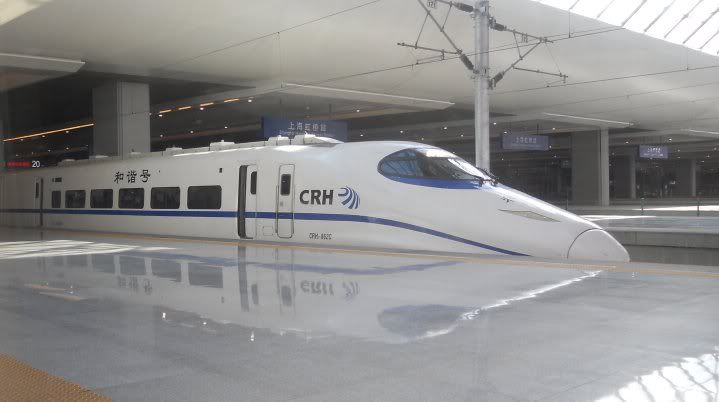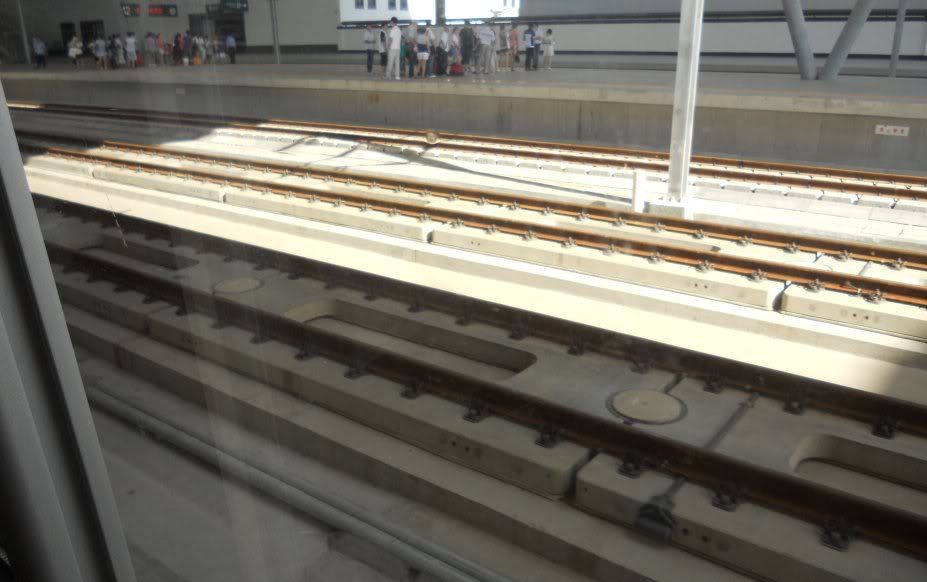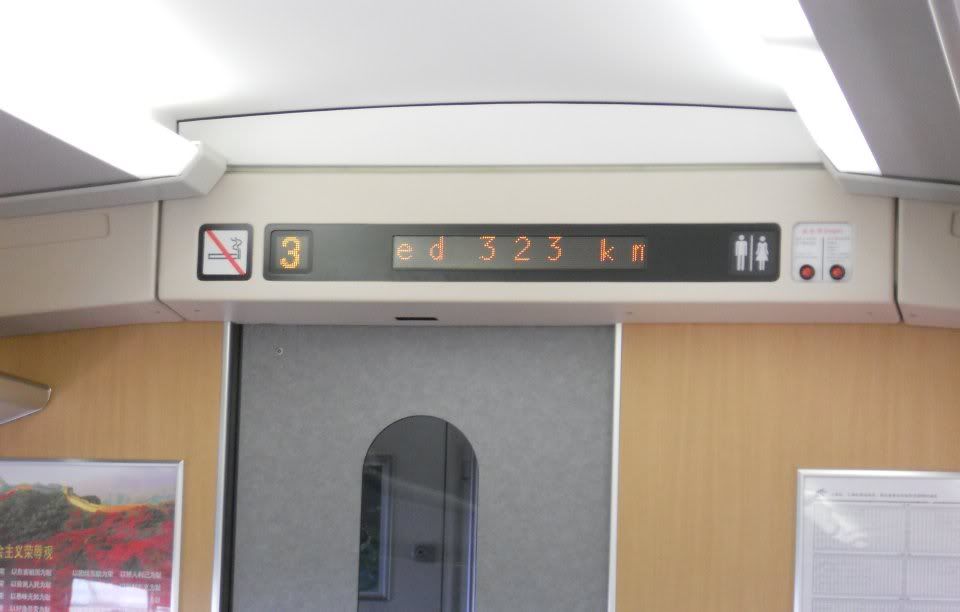
Posted on 07/25/2010 6:38:48 PM PDT by PugetSoundSoldier
There's a big push in some corners of the US transportation industry to "bring high speed rail to America". Visions of relaxed, latte-sipping trips over the nation, no lines for security, low cost trips are certainly heady ideas, but do they bear out? Let's take a critical, cold, calculating look at the reality of the situation.
As many know, I split my time between the US (Seattle, WA area) and Asia (predominantly Shanghai, China). China's been on a high speed rail building frenzy recently, and there are thousands of kilometers of line laid, with thousands more to come. Soon most of the larger Chinese cities in the East will be connected by high speed rail.
Just yesterday I rode one of these new marvels: the high speed rail line from Shanghai Hong Qiao (a behemoth of a transportation hub, consisting of an airport with two, 3400 meter runways, a bus terminal, a rail terminal, and a subway station) to Suzhou, a small town (well, by Chinese standards: only 6 million people) about 130 km away.
Hong Qiao is massive, even by Chinese standards. Not only are there 75 airline gates, but 36 long distance bus slots, 16 rail platforms, eight taxi stands (each capable of handling 800+ taxis at a time) and a full-size subway terminal. Soaring ceilings and highly polished marble and granite floors abound, and there is a good amount of space as befits China's 4th busiest airport/transportation terminal.
What does one of these new trains look like? Sleek and streamlined, as you would expect from a train capable of 300+ kilometers per hour:

These speedsters ride on some pretty specialized and dedicated rail lines, as you would expect:

Heavily bedded, full-length concrete foundations, and track ties every 20 cm. Absolute rigidity and stability is required for a train capable of such high speeds. And they do move right along:

Yes, that's 323 kilometers per hour, a hair over 200 miles per hour. It's no slouch in terms of speed! Fast, clean, relatively spacious transportation. And the ticket price of 41 RMB each way (about $6 USD) is quite cheap, too - nearly as cheap as the old, slower rail lines (which, at 26 RMB are a good discount, but take 50 minutes to cover the same distance we sped across in just 20 minutes).
So why do I say that high speed rail will not work in the US? One word:
Ridership
You see, I rode train G7130, which departed Hong Qiao on Sunday morning at 7:51 AM. And I rode train G7273 back on Sunday evening, which left Suzhou at 7:18 PM. And in each case, EVERY seat was taken, and it was standing-room-only at the ends of the cars.
Sixteen cars per train. Eighty five seats per car. And another 15-20 people standing in the baggage areas of each car. Over 1600 passengers on each train.
And there are 70 such trains a day between Suzhou and Hong Qiao. And every single one is full. Do the math - that is 112,000 riders per day on a single, 20 minute ride. And it's like that 7 days a week (remember, I rode on a Sunday and still had to buy my tickets a day in advance to guarantee a seat).
Close to 800,000 riders a week. Over 40 million a year on a single line. That's 25% more than rode ALL of Amtrak last year. And this is just a single line (not even the busiest - that title is reserved for Beijing to Tianjin, and Guangzhou to Shenzhen).
There are no discounts in China; you pay the full fare, no free tickets. That's $672,000 per day in revenue on that single train.
I talked a bit with with Wang Xiaoyan, the director of G7130 as we sped through the city. In her trademark skirt, black shoes, neatly pressed blouse, buttoned vest, and cap (with the proudly displayed "director" arm band), she provided a few details to this gao da lao wai (big and large foreigner):
China spent 23 billion RMB (about $3.4 billion USD) to deploy this stretch of track. With ridership of 35 million per year, and operating costs of 32 RMB per passenger, China expects to recover its investment in about 10 years, when the tracks need to be reworked (every 8-15 years you need to rebed and replace the tracks, to account for settling and shifting of the line).
In other words, China's doing this not because they have billions of people to move (which they do), but because it will not be an economic drain on the economy. It will cover its own costs, including maintenance.
Additionally, the construction costs are amazingly low - only $45 million per mile. Thanks to the cheap labor costs in China, and the incredibly flat terrain (Hong Qiao is at 3 meters elevation above sea level; Suzhou is at 5 meters - less than 7 feet difference, and it's completely flat between the two locations) China can build the rail for a low cost.
Consider the recent London-to-Edinburgh high speed rail line - $55 billion for 534 kilometers (note: the distance from London to Edinburgh is 331 miles, but the plan requires 1500 miles of line to make that distance a reality; you need to deploy more than just the lineal distance between locations). That's $166 million per mile, about 4 times the cost of that in China. Deploying high speed rail in the US will be much closer to the prices seen in the UK as compared to those in China, especially when you start to factor in the montainous and varied terrain in the US, as compared to most of Eastern China (and as a point of reference, Seattle's recent Link Light Rail had a cost of $179 million per mile, in line with the UK costs of deployment).
Given the plan for a 17,000 mile (27,000 kilometer) network in the US, we would see costs of $2.8 TRILLION to deploy this network (at UK line prices). A massive outlay of cash, orders of magnitude larger than that planned by China for its entire network (which already is the largest in the world, and growing rapidly).
And ridership will be lower, as well. Consider that a single segment of one line inside China eclipses all rail riders in the US. If we assumed that US ridership would increase by a factor of 10 - 300 million riders a year - and that the lines had a 25 year lifespan before being replaced (about twice what is realistic), we'd see that the per-rider capital costs alone would be $376 per trip. And this assumes 0% cost of money (interest free loans/bonds issued). No financing costs, and a 20X factor in the use of the line and we're still at close to $400 per rider per day in subsidies.
This does not include operating costs, either. Three Hundred Seventy Six dollars PER TRIP. Each of those 300 million trips each year, with a $376 subsidy tacked on.
When you run the numbers, it becomes painfully obvious why high speed rail should be shunned in the US - it simply does not make sense. We have too few people spread over too large an area, with too high of a deployment cost to make this anywhere near a reasonable approach to transportation in the US. It may make sense for a select few tiny lines (the famed NE corridor, for example), but as a realistic national network? The numbers just don't add up.
PEAK OIL
Amtrak ridership will continue to increase whether you like it or not.
That is what I said in my post. If you read it, you wouldn't be lumping me in with Willie. I was trying to tell him he was full of shit. You just did it way better than I did.
I took that as an FYI ping and not directed at you.
“Amtrak ridership will continue to increase whether you like it or not.”
Well it couldn’t get much lower.
Learned from the Steam-engine Willie school of debating techniques
Totally, it wasn’t to lump you in with fantasy-land Willie at all. Just some fleshed out concepts that I know Willie will ignore, but others may glean some education from.
High speed rail in the US makes ZERO economic sense. If it happens, it happens simply for political reasons only. Because someone wants a jobs bill, or wants to “be like Europe” or some other nonsense.
FWIW, there is a high speed train between Shanghai and Xiamen; it takes about 7 hours and costs 500 RMB. I looked at it for this Thursday’s trip down to Southern China. But considering a business class airplane ticket costs 650 RMB (about $20 more), and takes about 80 minutes, well, I can now fly down in the morning, do my 5-6 hours of work, then fly back. All in one day, versus a minimum 1 night stay in Xiamen if I went via train.
Xiamen’s a beautiful city, but I’m not looking to vacation right now...
They always want to force me to ride public transportation, but they never put a bus that will take me where I want to go, when I want to go there.
FYI, in 1865, when the first NYC subway opened, Manhattan's population density was 35K per square mile. It is now 70K per square mile. Most Chinese cities are like the biggest American cities, ex-NYC, in terms of population density - closer to Long Island than NYC. Shanghai's population density is only 7K per sq mile. Beijing's is 3.4K per sq mile. Bombay and Madras are far more densely populated, with 59K and 69K per sq mile respectively. Again, just FYI.
Shanghai’s only that low-density if you include Jiading, Baoshan, Minhang, and Pudong, all of which have thousands of acres of undeveloped land waiting for more people. AND then tack on the outer suburbs (Songjiang, Fengxian, etc) and the islands (Chongming).
It would be like taking Los Angeles and including all of Ventura County and Riverside County in the density calculation. Yeah, it’s “only an hour” to those areas, but they’re well outside of the urban core.
Get inside Shanghai “proper” (inside the Puxi area - the core 9 districts inside the A20 ring road) which is 281 square kilometers, about 110 square miles, and you’re over 28,000 per square kilometer, which would be about 72,000 per square mile (2.56 square kilometers per square mile).
And I think yesterday nearly all of them were on lines 2 and 9 as I traversed Shanghai...
Disclaimer: Opinions posted on Free Republic are those of the individual posters and do not necessarily represent the opinion of Free Republic or its management. All materials posted herein are protected by copyright law and the exemption for fair use of copyrighted works.